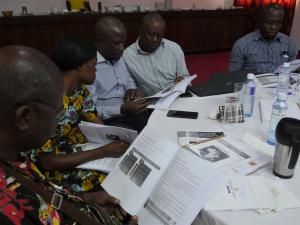Sierra Leone Adapts new WHO guidelines for improved disease surveillance for the Africa region
Sierra Leone has adapted the third edition of the Integrated Disease Surveillance and Response (IDSR) technical guidelines 2019. The new guidelines were released by the World Health Organization (WHO) Regional Office for Africa in August this year to incorporate recent recommendations by expert panels on strengthening the International Health Regulations (IHR 2005) and global health security.
Adaptation of the guidelines is a way of aligning Sierra Leone’s public health security needs and priorities with current technologies, information, tools and materials taking into consideration new trends and developments such as evidence on important diseases, conditions and events in the world.
As a One Health approach to improving health outcomes in the human, animal and environmental sectors, the adaptation process is being carried out by the Ministry of Health and Sanitation with strong collaboration with the Ministries of Agriculture, and the Environment; Public Health Training Institutions and partners from WHO, CDC, USAID, FAO, Public Health England and AFENET. Funding for this activity is being provided by the Korean International Cooperation Agency, KOICA.
“The new guidelines have several training modules and for us to correctly adapt these to our local context in Sierra Leone, we had to involve all the strategic sectors, programmes and partners in the process. This is to strengthen partnership and promote ownership so that progress would be sustained,” says Charles Njuguna, Health Security and Emergencies Lead at WHO Country Office in Sierra Leone. “Involvement of training institutions is vital as we prepare to launch the IDSR-IHR Pre-and-In-service curricula that are anchored on these new guidelines.”
The country has reviewed its list of priority diseases, conditions and events under the various categories such as epidemic prone diseases and events that require immediate reporting, diseases targeted for eradication or elimination and other diseases of public health importance. The prioritization ensures that available resources are used for the most important needs in the county.
Suspected diseases, conditions and events that are reported immediately are the ones that could have significant public health impact if not urgently investigated and responded to. Hence, the new edition of the IDSR guidelines placed emphasis on One Health, surveillance at points of entry, community and electronic based approaches to surveillance and disaster risk management as well as innovative ways of building public health capacity using the IDSR eLearning tools.
The IDSR Strategy was launched in 1998 followed by release of the first edition technical guidelines in 2001. These have been reviewed over the years to keep them relevant based on current evidence and consensus information that holistically address compliance with the provisions of the IHR 2005. The overarching goal is to ensure that there are strong public health surveillance and response systems in the African countries.
Following the adaptation, the new information and materials will be popularized through trainings of health workers as a way of synchronizing the Sierra Leone’s reporting system with the new trend. The trainings will be rolled out to every health facility across Sierra Leone.



